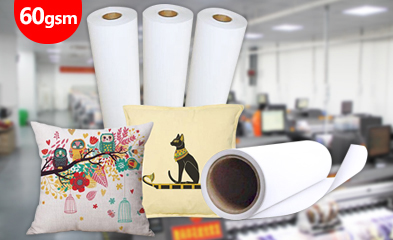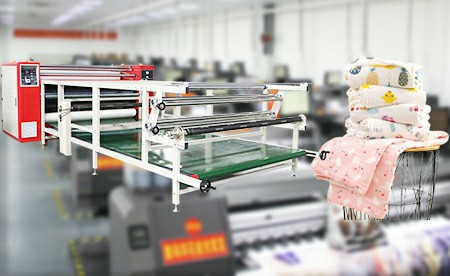HOT SALE
APPLICATION
Phone:+86-15215969856 E-Mail: 396838165@qq.com
In the realm of digital textile and product design, knowing how different inks work with various transfer materials is super important. A question that pops up a lot, especially for newbies and even pros, is: \What kind of ink should I use with heat transfer paper?\ This piece will break down the differences between heat transfer paper and sublimation paper, explain how ink types affect printing, and discuss the outcome of using normal ink on sublimation paper. With helpful tips from top players like Changfa Digital, we’ll steer you toward the best mix for awesome results.
Basics of Heat Transfer Paper and Sublimation Paper
Both heat transfer paper and sublimation paper are used to put printed patterns on stuff like cloth, pottery, or metal. But they operate in unique ways and are made for specific printing jobs.
Key Differences Between Heat Transfer Paper and Sublimation Paper
Heat transfer paper usually pairs with pigment or dye inks and works with many kinds of printers. It has a special layer that keeps the ink on the paper’s surface until a heat press moves it to another material. On the other hand, sublimation paper has a unique coating. This coating holds sublimation ink until heat changes it into a gas, which then blends right into polyester materials.
Changfa Digital is a professional sublimation paper manufacturer and has been supplying the digital printing service for 15+ years. It’s the factory for sublimation papers, handling everything from base paper to coating, cutting, and shipping worldwide.
How Each Type Functions in the Printing Process
Heat transfer paper prints a design that stays on top of the material after pressing. This often leaves a slight film or rough feel. Sublimation paper, however, lets the ink turn into gas with high heat. It then mixes with polyester fibers at a tiny level, giving bright, tough prints with no extra feel.
The Role of Ink in Heat Transfer Applications
The success of any heat transfer job relies a lot on picking the right ink for your chosen material.
Types of Ink Used in Heat Transfer Printing
There are a few kinds of inks for heat transfer tasks. Each type has special traits that match different papers and surfaces.
Dye-Based Inks
Dye-based inks dissolve in water and give bright shades. But they don’t last very long. They’re fine with regular heat transfer papers. However, they’re not good for sublimation because they can’t turn into gas when heated.
Pigment Inks
Pigment inks resist fading better than dye-based ones. They’re often picked for dark fabric designs since they stay on the surface instead of soaking in.
Sublimation Inks
Sublimation Ink (High density): Color: CY, MG, YL, BK; Used For: Epson I3200 nozzle (more than 8 nozzle). These inks have special dyes that change from solid to gas under heat. This makes them perfect for sublimation paper.
They use eco-friendly solvents, which are safe and nontoxic. Plus, they offer a wide range of colors, vivid hues, smooth flow, and a washproof level of 4-5.
Compatibility of Inks with Different Papers
Pairing the wrong ink and paper can mess up your print or even ruin the job. For instance, pigment or dye inks won’t stick well to sublimation paper because they don’t match chemically.
Can Normal Ink Be Used on Sublimation Paper?
This is a super common question, especially from beginners who might have an inkjet printer already loaded with standard dye or pigment cartridges.
What Happens When You Use Normal Ink on Sublimation Paper
If you use regular ink, like dye or pigment, on sublimation paper, it won’t turn into gas under heat. Instead of bonding with polyester fibers, it just vanishes or smudges. This leads to pale or patchy transfers.
Limitations and Risks of Using Non-Sublimation Ink
Using the wrong ink can block print heads meant for sublimation. It might even harm your printer completely. Also, the prints won’t be bright or last long since they don’t connect with the material during heat pressing.
Results in Terms of Print Quality and Durability
Prints made with normal ink on sublimation paper often look dim. They fade fast after a wash or time in the sun. This ruins one of sublimation’s big perks—long-lasting, clear images.
Why Sublimation Ink is Essential for Sublimation Paper
For top-notch results with sublimation methods, matching the right stuff together is a must.
Chemical Properties That Enable Proper Transfer
Sublimation inks are made with dyes that react to high heat. They skip the liquid stage and go straight to gas. This process, called sublimation, works only with these inks. They pair well with the special layer on sublimation papers, which holds the gas dyes briefly before they move to polyester surfaces.
Heat Activation and Color Bonding with Substrates
At temperatures of about 180–200°C (356–392°F), sublimation ink turns to vapor. It moves from the coated paper into open polyester pores. When it cools, it hardens, creating lasting color that won’t peel or break over time.
Choosing the Right Combination for Optimal Results
Whether you’re just starting or growing your setup, picking gear that works together ensures great transfers every single time.
Matching Printer, Ink, and Paper Types
Matching is key. Use pigment or dye inks only with heat transfer papers. When working with sublimation papers, stick to printers loaded with sublimation inks.
Desktop Printers vs. Dedicated Sublimation Printers
Some desktop printers can be tweaked for light sublimation work with refillable cartridges. But pros often go for dedicated machines, like those made for Epson I3200 nozzles (2~4 nozzle), because they deliver steady, high-quality results.
Recommended Setups for Beginners and Professionals
Newbies might begin with small A4-sized printers and matching cartridges. Meanwhile, pros gain from bigger setups, like wide-format printers teamed with Changfa Digital’s high-density sublimation inks and coated papers in widths up to 190cm.
Common Mistakes When Using Heat Transfer or Sublimation Products
Skipping errors saves time and money. It also helps keep results steady across different batches.
Using Incorrect Ink Types with Specific Papers
A frequent slip-up is using regular dye or pigment ink on sublimation papers. As mentioned before, this gives bad image quality. Always check if your printer matches the supplies before buying.
Misunderstanding Temperature and Pressure Settings
Every material needs exact heat, time, and pressure settings during pressing. If you don’t adjust these right, you might get blurry effects or uneven prints. This can happen even with the correct materials.
Brief Introduction to Changfa Digital as a Reliable Supplier
As a top name in digital printing solutions, Changfa Digital is the professional sublimation paper manufacturer and has been supplying the digital printing service for 15+ years. It’s the factory for sublimation papers.
They handle everything from base coating to cutting workshops. Their rolls range from 61cm to 190cm for large-scale needs. They export 120 containers monthly to places all over the world.
Overview of Products Offered by Changfa Digital
Their product list includes:
- Sublimation Paper
- Printers & Inks
- Heat Transfer Machines
- Tissue/Protective Papers
All come with OEM/ODM options to fit client needs around the globe.
Commitment to Quality and Global Support
We provide 24-hour service. We have professional staff online. We have a skilled team ready to help, no matter where your business is located.
Conclusion
Picking the right mix of printer, ink type, and material—whether heat transfer or sublimation paper—decides if your end product meets high standards or falls flat. Knowing how each piece fits together and avoiding quick fixes, like using normal ink on sublimation paper, is vital for success in digital printing.
FAQs:
Q1: Can I turn my regular printer into a sublimation printer?
A: Yes, but only some models, like the Epson EcoTank series, can be switched. You must clear out old dye or pigment inks fully before adding sublimation inks offered by Changfa Digital. Keep in mind, doing this might cancel warranties unless a pro handles it.
Q2: Is there any plus to using high-density sublimation ink?
A: For sure! High-density formulations ensure greater black coverage after transferring. This creates deeper contrasts, which are key for photo prints or detailed designs on clothes like sportswear.
Q3: What materials work best with sublimation printing?
A: Only polyester-coated surfaces are ideal. They let gaseous dyes from sublimation inks sink into their structure during heat. This gives bright, lasting colors that other methods can’t match.










